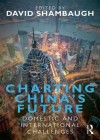Written by: David Shambaugh
Routledge, London and New York, 2011.
ISBN 9780415619554, 187 pp
Reviewed by: Dr Jingdong Yuan
This edited volume could not have come at a more opportune time. With China overtaking Japan as the world’s second largest economy and with its growing political influence and military power, there are increasing interests in and analyses of what China’s future holds. Will this rising power challenge the existing international system, or will it become a responsible stakeholder and contribute to global and regional peace and prosperity? Given its upcoming leadership transition and its more assertive external behavior in recent years, the stakes are high.
Charting China’s Future provides the reader with concise, intelligent, and forward-looking essays written by some of the world’s top China scholars. The essays cover China’s domestic developments, its foreign relations, and its growing interactions with Taiwan, and offer insightful analyses of both recent developments and likely future.
Without question, China’s future begins at home. Here the six essays that look at China’s political, economic, and social futures present a mixed picture. While the Chinese Communist Party, by its sheer size (almost 76 million members and growing) and its ubiquitous presence in all walks of life in China guarantees its tight control over the government and key institutions, the challenges it faces are more from within—how to handle corruption and minority discontent. At the same time, the Party needs to maintain a sustained rate of economic growth and increasingly must use its power to ensure more equitable distribution of wealth to minimise, if not completely prevent, rising social unrest. Both are tall orders given the worldwide recession and China’s still underdeveloped domestic market and consumption. Clearly, the tasks ahead will be daunting for the fifth-generation leadership poised to take the reins in late 2012.
However, reform and opening up during the three decades have deepened China’s integration into the global economy so much so that its future is just as affected by, as it can influence, its external environments. The next five essays in this book examine some of China’s key bilateral relationships and its growing role in the international arena. Clearly, managing major power relations remains the top priority for Beijing. Sino–US relations will dominate global politics in the coming decade as the two powers find themselves at once wresting in intense competition and engaged in cooperation, due largely to different expectations of benefits and responsibilities, and lack of strategic trust between the two. Overall, China’s presence and role in international affairs are expanding. In the former, the need for resources has Beijing rediscovering the importance of the developing world; at the same time, its growing participating in international peacekeeping and anti-piracy operations is indicative of China’s changing perspective of its own responsibilities, albeit still performed selectively.
The two essays on cross-Strait relations present different futures for mainland–Taiwan ties. While both acknowledge the stabilising impact of Beijing’s more patient and economically oriented policy toward Taiwan and Ma Ying-jeou’s emphasis on status quo and non-provocation, they also point out that the period of stability and growing economic interdependence could be disrupted either because of domestic politics in Taiwan or due to Beijing’s push for political negotiation. However, the January 2012 Taiwan elections and Ma’s return to office for another four-year term suggest that for the time being at least, the forces for stability and status quo on both sides of the Strait have prevailed.
In sum, this timely volume is a welcome addition to the growing literature on the rise of China and its global and regional implications. While most debates are informed by and focus on how China’s rise will affect the existing international system, Charting China’s Future looks at the domestic and international challenges Beijing is facing and will likely confront in the near term and carefully analyses both the impetuses of, and options for, Chinese policies in the coming years.

